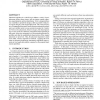Free Online Productivity Tools
i2Speak
i2Symbol
i2OCR
iTex2Img
iWeb2Print
iWeb2Shot
i2Type
iPdf2Split
iPdf2Merge
i2Bopomofo
i2Arabic
i2Style
i2Image
i2PDF
iLatex2Rtf
Sci2ools
ICCAD
2005
IEEE
2005
IEEE
Computational geometry based placement migration
Placement migration is a critical step to address a variety of postplacement design closure issues, such as timing, routing congestion, signal integrity, and heat distribution. To fix a design problem, one would like to perturb the design as little as possible while preserving the integrity of the original placement. This work presents a novel computational geometry based placement migration method, and a new stability metric to more accurately measure the “similarity” between two placements. It has two stages, a bin-based spreading at coarse scale and a Delaunay triangulation based spreading at finer grain. It has clear advantage over conventional legalization algorithms such that the neighborhood characteristics of the original placement are preserved. Thus, the placement migration is much more stable, which is important to maintain. Applying this technique to placement legalization demonstrates significant improvements in wire length and stability compared to other popular l...
Conventional Legalization Algorithms | Hardware | ICCAD 2005 | Placement Legalization | Placement Migration Method |
Related Content
| Added | 16 Mar 2010 |
| Updated | 16 Mar 2010 |
| Type | Conference |
| Year | 2005 |
| Where | ICCAD |
| Authors | Tao Luo, Haoxing Ren, Charles J. Alpert, David Zhigang Pan |
Comments (0)

